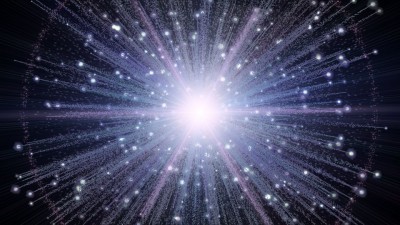A growing body of evidence indicates that “Big Bang” is a funny choice of names
We’ve now had almost a year to inspect the images that scientists finally released from the Microwave Anisotropy Probe. This may sound like an oven inspection (or something truly humiliating), but is actually a satellite launched in 2001 to observe the microwave background remaining from the explosive beginnings of our cosmos. In light of the importance of this topic for, uh, well, for purposes of knowing about the explosive beginnings of our cosmos, let us review what contemporary science tells us.
 Modern cosmologists embrace the “Big Bang Theory,” which states that the universe formed in the incredibly rapid expansion of a “primeval atom.” To fully understand the Big Bang, we must first imagine time in its smallest increments, such as micro, nano, harpo and groucho seconds. We must also accept that time and space are inextricably connected, like in timeshare units, but without realtors.
Modern cosmologists embrace the “Big Bang Theory,” which states that the universe formed in the incredibly rapid expansion of a “primeval atom.” To fully understand the Big Bang, we must first imagine time in its smallest increments, such as micro, nano, harpo and groucho seconds. We must also accept that time and space are inextricably connected, like in timeshare units, but without realtors.
To understand this “spacetime” connection, imagine you want to meet a friend at a restaurant atop a hotel. How many “coordinates” will it take to identify this meeting “event”? You will need two coordinates to locate the meeting on a flat plane – for example, Hollywood and Vine – and another coordinate to pinpoint the height – for example, the 12½ floor. That’s three coordinates; but have you given enough information to ensure a meeting? No, because you didn’t mention the dress code and without a tie he won’t get in. More importantly, without telling him the time, you haven’t fully defined the event.
In short, to ensure that this luncheon “event” occurs, you’ll need three spatial coordinates, one temporal coordinate, and a major credit card, thus four coordinates: front-back, up-down, side-to-side, and say when?
Now imagine a time when these four coordinates – which starting this very sentence we’ll call Dimensions – were unified. At that pre-geometric moment, the four primary Forces – the strong, the weak, the electromagnetic, and the, uh, fourth one – were also unified, creating a “primordial stew” so dense that light could not penetrate, like my Aunt Muriel’s chicken soup. Suddenly a BIG BANG occurs and this pre-geometric plasma begins an expansion more rapid than anything occurring since, including Kirstie Alley in retirement.
Within yoctoseconds quarks form; the Forces begin to separate; and, as physicist Chris Quigg puts it: “In supersymmetric unified theories of the fundamental interactions, virtual top quarks can drive the spontaneous breakdown of electroweak symmetry, provided [and this is key] that top is very massive.” I couldn’t have said it better myself.
Still let me try, in English: What’s happening is that just after the Big Bang everything is moving away from everything else, like at my friend Bernie’s second wedding. Even more remarkable is that space itself is expanding.
How is that possible? Imagine a stained spandex leotard worn by a pregnant woman, or perhaps Kirstie Alley. As the wearer grows wider, every stain moves away from every other stain, like raisins in raisin bread. Which is, maybe, a better analogy. So imagine a raisin bread baking in an oven. As the dough rises every raisin moves away from every other raisin until it’s edible only with butter or jam. That’s the universe today, except that the raisins are really stars and galaxies, the dough is so-called “dark matter” and there is no butter or jam.
How do we know this esoteric model of expanding Dimensions is correct? Mainly by the presence of “cosmic background radiation,” the effluence remaining from the Big Bang, discovered by two Bell Labs scientists trying to eavesdrop on a conversation. More recent evidence was gathered by COBE, the Cosmic Background Explorer, NASA’s 1990s effort to detect the predicted hiss persisting from creation. (This should not be confused with COMBE, the Comic Background Explorer, a 1960s effort to discover the source of the mysterious background laughter present on many TV soundtracks. Ultimately that source was determined to be low-level chuckles and guffaws remaining after a primeval sitcom, possibly The Honeymooners.)
Ironically, this growing body of evidence has confirmed that “Big Bang” is a poor choice of names: With the newborn cosmos a pre-spatial “singularity,” and with nothing around for comparison, the universe’s origin was not “big.”
Nor was it a “bang.” As a philosopher once asked: If a tree falls in the forest and no one hears it, are they deaf or something? Similarly, with no one to experience sound, and no space existing through which sound waves could travel, the birth of the cosmos was technically not a “bang” either.
So despite having a highly predictive theory of how the Universe began, scientists have done poorly at naming it. If anyone has any suggestions, please let Science know. (And feel free to post them below.)
- Passover Song Parodies - April 8, 2025
- My Interview With Isaac Asimov (a Memoir) - May 4, 2024
- Excerpts from Santa’s Tell-All Interview - December 26, 2023

